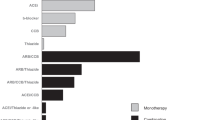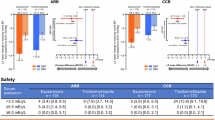Abstract
It has been reported that a substantial majority of hypertensives receive insufficient blood pressure (BP) control. As combination therapy for the treatment of hypertension, Ca channel blockers (CCBs), angiotensin II (AII) receptor blockers (ARBs), and/or AII-converting enzyme (ACE) inhibitors are mainly prescribed, while the efficacy of α1-blockers in such combination therapy remains unknown. The aim of this study was to investigate the efficacy of a low dose of an α1-blocker added to combination therapy with CCBs and either ARBs or ACE inhibitors for the treatment of hypertension. Subjects were 41 hypertensive patients (23 women and 18 men, mean age 66±12 years) who had been followed at the National Kyushu Medical Center. All patients showed poor BP control despite haven taken a combination of CCBs and ARBs or ACE inhibitors for more than 3 months. Doxazosin at a dose of 1 to 2 mg was added to each treatment regimen. The changes in various clinical parameters, including BP and blood chemistry, following the addition of doxazosin were then evaluated. The mean follow-up period was 170 days. BP decreased from 152±14/81±12 mmHg to 135±14/70±11 mmHg after the addition of doxazosin at a mean dose of 1.5 mg/day (p<0.001). When good systolic blood pressure (SBP) control was defined as <140 mmHg, the prevalence of patients with good SBP control increased from 24% to 61% (p<0.01). Similarly, the prevalence of patients with good diastolic blood pressure (DBP) control (<90 mmHg) increased from 78% to 98% (p<0.01). Patients whose SBP decreased more than 10 mmHg (n=25) showed significantly higher baseline SBP, serum total cholesterol and low-density lipoprotein (LDL) cholesterol levels compared to those who showed less SBP reduction (<10 mmHg) (n=16, p<0.01). Comparable BP reductions were obtained between obese (body mass index [BMI] ≥25, ΔBP at 3 months: −15±15/−12±9 mmHg, n=18) and non-obese (BMI<25, ΔBP: −14±19/−7±8 mmHg, n=23) patients. The results suggest that addition of a low dose of the α1-blocker doxazosin effectively reduces BP in patients taking CCBs and ARBs or ACE inhibitors. Thus, doxazosin seems to be useful as a third-line antihypertensive drug.
Similar content being viewed by others
Article PDF
References
Japanese Society of Hypertension Guidelines Subcommittee for the Management of Hyperetnsion : Guidelines for the management of hypertension for general practitioners. Hypertens Res 2001; 24: 613–634.
Chobanian AV, Bakris GL, Black HR, et al, National High Blood Pressure Education Program Coodination Committee : The seventh report of the Joint National Committee on Prevention, Detection, Evaluation, and Treatment of High Blood Pressure: the JNC 7 report. JAMA 2003; 289: 2560–2572.
Guidelines Committee : 2003 European Society of Hypertension–European Society of Cardiology guidelines for the management of arterial hypertension. J Hypertens 2003; 21: 1011–1053.
Bakris G : Maximizing cardiorenal benefit in the management of hypertension: achieving blood pressure goals. J Clin Hypertens 1999; 1: 141–147.
Cushman WC, Ford CE, Cutler JA, et al: Success and predictors of blood pressure control in diverse north America settings: the antihypertensive and lipid-lowering treatment to prevent heart attack trial (ALLHAT). J Clin Hypertens 2002; 4: 393–404.
Ferrara LA, Marino LD, Russo O, Marotta T, Mancini M, on behalf of the DoCHH Study Group: Doxazosin and captopril in mildly hypercholesterolemic hypertensive patients. The doxazosin-captopril in hypercholesterolemic hypertensive study. Hypertension 1993; 21: 97–104.
Rosenthal J : Control of coronary heart disease risk factors with doxazosin as monotherapy and in combination therapy. Am Heart J 1988; 116: 1763–1766.
Shieh SM, Sheu WHH, Shen DC, Fuh MMT, Chen YDI, Reaven GM : Glucose, insulin, and lipid metabolism in doxazosin-treated patients with hypertension. Am J Hypertens 1992; 5: 827–831.
Levy D, Walmsley P, Levenstein M, for the Hypertension and Lipid Trial Study Group: Principal results of the hypertension and lipid trial (HALT): a multicenter study of doxazosin in patients with hypertension. Am Heart J 1996; 131: 966–973.
The ALLHAT Officers and Coordinators for the ALLHAT Collaborative Research Group: Major outcomes in high-risk hypertensive patients randomized to angiotensin-converting enzyme inhibitor or calcium channel blocker vs diuretic. The Antihypertensive and Lipid-Lowering Treatment to Prevent Heart Attack Trial (ALLHAT). JAMA 2002; 288: 2981–2997.
Troffa C, Manunta P, Fulgheri PD, et al: Efficacy and tolerability of doxazosin alone or in combination with chlorthalidone in essential hypertension. Curr Ther Res 1994; 55: 22–31.
Searle M, Dathan R, Dean S, Christensen CC, Westheim A : Doxazosin in combination with atenolol in essential hypertension: a double-blind placebo-controlled multicentre trial. Eur J Clin Pharmacol 1990; 39: 299–300.
Donnelly R, Elliott HL, Meredith PA, Howie CA, Reid JL : Combination of nifedipine and doxazosin in essential hypertension. J Cardiovasc Pharmacol 1992; 19: 479–486.
Englert RG, Mauersberger H : A single-blind study of doxazosin in the treatment of essential hypertension when added to nonresponders to angiotensin-converting enzyme inhibitor therapy. Am Heart J 1988; 116: 1826–1832.
Lindner UK, Manteuffel GE, Stafunsky M : The addition of doxazosin to the treatment regimen of hypertensive patients not responsive to nifedipine. Am Heart J 1988; 116: 1814–1820.
Black HR, Sollins JS, Garofalo JL : The addition of doxazosin to the therapeutic regimen of hypertensive patients inadequately controlled with other antihypertensive medications: a randomized, placebo-controlled study. Am J Hypertens 2000; 13: 468–474.
Ohta Y, Tsuchihashi T, Ueno M, et al: Relationship between the awareness of salt restriction and the actual salt intake in hypertensive patients. Hypertens Res 2004; 27: 243–246.
Ohta Y, Tsuchihashi T, Onaka U, Eto K, Tominaga M, Ueno M : Long-term compliance of salt restriction in Japanese hypertensive patients. Hypertens Res 2005; 28: 953–957.
Danhlöf B, Sever PS, Poulter NR, et al: Prevention of cardiovascular events with an antihypertensive regimen of amlodipine adding perindopril as required versus atenorol adding bendroflumethiazide as required, in the Anglo-Scandinavian Cardiac Outcomes Trial–Blood Pressure Lowering Arm (ASCOT-BPLA): a multicentre randomized controlled trial. Lancet 2005; 366: 895–906.
Miura Y, Watanabe M, Yoshinaga K, on behalf of the Japanese Doxazosin Study Group: An evaluation of the efficacy and safety of doxazosin in hypertension associated with renal dysfunction. Am Heart J 1991; 121: 381–388.
The ALLHAT Officers and Coordinators for the ALLHAT Collaborative Research Group: Major cardiovascular events in hypertensive patients randomized to doxazosin vs chlorthalidone: the Antihypertensive and Lipid-Lowering Treatment to Prevent Heart Attack Trial (ALLHAT). JAMA 2000; 283: 1967–1975.
Pickering TG, Levenstein M, Walmsley P, for the Hypertension and Lipid Trial Study Group: Nighttime dosing of doxazosin has peak effect on morning ambulatory blood pressure. Result of the HALT study. Am J Hypertens 1994; 7: 844–847.
Kario K, Schwartz JE, Pickering TG : Changes of nocturnal blood pressure dipping status in hypertensives by nighttime dosing of α-adrenergic blocker, doxazosin. Results from the HALT study. Hypertension 2000; 35: 787–794.
Kario K, Pickering TG, Umeda Y, et al: Morning surge in blood pressure as a predictor of silent and clinical cerebrovascular disease in elderly hypertensives: a prospective study. Circulation 2003; 107: 1401–1406.
Kario K, Pickering TG, Hoshide S, et al: Morning blood pressure surge and hypertensive cerebrovascular disease: role of the alpha adrenergic sympathetic nervous system. Am J Hypertens 2004; 17: 668–675.
Toyonaga S, Nakatsu T, Suezawa C, Matsubara H, Sogou T, Kusachi S : Relationship between body mass index and anti-hypertensive efficacy of doxazosin according to a survey of Japanese patients. J Intern Med Res 2004; 32: 176–184.
Author information
Authors and Affiliations
Corresponding author
Rights and permissions
About this article
Cite this article
Ohta, Y., Tsuchihashi, T., Onaka, U. et al. Usefulness of the α1-Blocker Doxazosin as a Third-Line Antihypertensive Drug. Hypertens Res 30, 301–306 (2007). https://doi.org/10.1291/hypres.30.301
Received:
Accepted:
Issue date:
DOI: https://doi.org/10.1291/hypres.30.301



